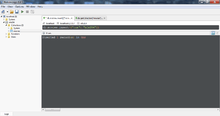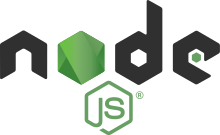MongoDB
 | |
| Developer(s) | MongoDB Inc. |
|---|---|
| Initial release | February 11, 2009[1] |
| Stable release |
4.0.3[2]
/ 9 October 2018 |
| Preview release |
4.1.2[3]
/ 14 August 2018 |
| Repository |
|
| Written in | C++, C and JavaScript |
| Operating system | Windows Vista and later, Linux, OS X 10.7 and later, Solaris,[4] FreeBSD[5] |
| Available in | English |
| Type | Document-oriented database |
| License | Various; see § Licensing |
| Website |
www |
MongoDB is a free and open-source cross-platform document-oriented database program. Classified as a NoSQL database program, MongoDB uses JSON-like documents with schemata. MongoDB is developed by MongoDB Inc., and is published under a combination of the GNU Affero General Public License and the Apache License.
History
10gen software company began developing MongoDB in 2007 as a component of a planned platform as a service product. In 2009, the company shifted to an open source development model, with the company offering commercial support and other services. In 2013, 10gen changed its name to MongoDB Inc.[6]
On October 20, 2017, MongoDB became a publicly-traded company, listed on NASDAQ as MDB with an IPO price of $24 per share.[7]
Main features
Ad hoc queries
MongoDB supports field, range query, and regular expression searches.[8] Queries can return specific fields of documents and also include user-defined JavaScript functions. Queries can also be configured to return a random sample of results of a given size.
Indexing
Fields in a MongoDB document can be indexed with primary and secondary indices.
Replication
MongoDB provides high availability with replica sets.[9] A replica set consists of two or more copies of the data. Each replica set member may act in the role of primary or secondary replica at any time. All writes and reads are done on the primary replica by default. Secondary replicas maintain a copy of the data of the primary using built-in replication. When a primary replica fails, the replica set automatically conducts an election process to determine which secondary should become the primary. Secondaries can optionally serve read operations, but that data is only eventually consistent by default.
Load balancing[10]
MongoDB scales horizontally using sharding. The user chooses a shard key, which determines how the data in a collection will be distributed. The data is split into ranges (based on the shard key) and distributed across multiple shards. (A shard is a master with one or more slaves.). Alternatively, the shard key can be hashed to map to a shard – enabling an even data distribution.
MongoDB can run over multiple servers, balancing the load or duplicating data to keep the system up and running in case of hardware failure.
File storage
MongoDB can be used as a file system, called GridFS, with load balancing and data replication features over multiple machines for storing files.
This function, called grid file system,[11] is included with MongoDB drivers. MongoDB exposes functions for file manipulation and content to developers. GridFS can be accessed using mongofiles utility or plugins for Nginx[12] and lighttpd.[13] GridFS divides a file into parts, or chunks, and stores each of those chunks as a separate document.[14]
Aggregation
MongoDB provides three ways to perform aggregation: the aggregation pipeline, the map-reduce function, and single-purpose aggregation methods.[15]
Map-reduce can be used for batch processing of data and aggregation operations. But according to MongoDB's documentation, the Aggregation Pipeline provides better performance for most aggregation operations.[16]
The aggregation framework enables users to obtain the kind of results for which the SQL GROUP BY clause is used. Aggregation operators can be strung together to form a pipeline – analogous to Unix pipes. The aggregation framework includes the $lookup operator which can join documents from multiple documents, as well as statistical operators such as standard deviation.
Server-side JavaScript execution
JavaScript can be used in queries, aggregation functions (such as MapReduce), and sent directly to the database to be executed.
Capped collections
MongoDB supports fixed-size collections called capped collections. This type of collection maintains insertion order and, once the specified size has been reached, behaves like a circular queue.
Transactions
Support for multi-document ACID transactions were added to MongoDB with the General Availability of the 4.0 release in June 2018.[17]
Editions
MongoDB Community Server
The MongoDB Community Edition is free and available for Windows, Linux, and OS X.[18]
MongoDB Enterprise Server
MongoDB Enterprise Server is the commercial edition of MongoDB, available as part of the MongoDB Enterprise Advanced subscription.[19]
Architecture
Programming language accessibility
MongoDB has official drivers for major programming languages and development environments.[20] There are also a large number of unofficial or community-supported drivers for other programming languages and frameworks.
Serverless access
MongoDB Stitch[21] provides serverless access to MongoDB and other services. Client librairies are available for JavaScript[22], iOS[23], and Android[24].
Management and graphical front-ends

The primary interface to the database has been the mongo shell. Since MongoDB 3.2, MongoDB Compass is introduced as the native GUI. There are products and third-party projects that offer user interfaces for administration and data viewing.[25]
Licensing
MongoDB is available at no cost under the GNU Affero General Public License, version 3.[26] The language drivers are available under an Apache License. In addition, MongoDB Inc. offers proprietary licenses for MongoDB.
Bug reports and criticisms
Security
Due to the default security configuration of MongoDB, allowing anyone to have full access to the database, data from tens of thousands of MongoDB installations has been stolen. Furthermore, many MongoDB servers have been held for ransom.[27][28]
Technical criticisms
In some failure scenarios where an application can access two distinct MongoDB processes, but these processes cannot access each other, it is possible for MongoDB to return stale reads. In this scenario it is also possible for MongoDB to roll back writes that have been acknowledged.[29] This issue was addressed since version 3.4.0 released in November 2016[30] (and back-ported to v3.2.12).[31]
Before version 2.2, concurrency control was implemented on a per-server process basis. With version 2.2, concurrency control was implemented at the database level.[32] Since version 3.0,[33] pluggable storage engines were introduced, and each storage engine may implement concurrency control differently.[34] With MongoDB 3.0 concurrency control is implemented at the collection level for the MMAPv1 storage engine,[35] and at the document level with the WiredTiger storage engine.[36] With versions prior to 3.0, one approach to increase concurrency is to use sharding.[37] In some situations, reads and writes will yield their locks. If MongoDB predicts a page is unlikely to be in memory, operations will yield their lock while the pages load. The use of lock yielding expanded greatly in 2.2.[38]
Up until version 3.3.11, MongoDB could not do collation-based sorting and was limited to byte-wise comparison via memcmp,[39] which would not provide correct ordering for many non-English languages when used with a Unicode encoding. The issue was fixed on August 23, 2016.
MongoDB queries against an index are not atomic and can miss documents which are being updated while the query is running and match the query both before and after an update.[40]
MongoDB World
MongoDB World is an annual developer conference hosted by MongoDB, Inc.[41]
See also
- List of server-side JavaScript implementations
- MEAN, a solutions stack using MongoDB as the database
- Server-side scripting
- TokuMX, a fork of MongoDB with stronger consistency and new index structures
References
- ↑ "State of MongoDB March, 2010". DB-Engines.
- ↑ "Release Notes for MongoDB 4.0 — MongoDB Manual". MongoDB.
- ↑ "Release 4.1.2 tag · GitHub". MongoDB.
- ↑ "How to Set Up a MongoDB NoSQL Cluster Using Oracle Solaris Zones". Oracle.
- ↑ "How-To: MongoDB on FreeBSD 10.x". FreeBSD News.
- ↑ "10gen embraces what it created, becomes MongoDB Inc". Gigaom. Retrieved 29 January 2016.
- ↑ Witkowski, Wallace (21 October 2017). "MongoDB shares rally 34% in first day of trading above elevated IPO price". MarketWatch. Dow Jones. Retrieved 26 February 2018.
- ↑ Davis Kerby. "Why MongoDB is the way to go". DZone.
- ↑ "Ridiculously fast MongoDB replica recovery Part 1 of 2". ClusterHQ.
- ↑ "Turning MongoDB Replica Set to a Sharded Cluster". Severalnines.
- ↑ "GridFS & MongoDB: Pros & Cons". Compose.
- ↑ "NGINX plugin for MongoDB source code". GitHub.
- ↑ "lighttpd plugin for MongoDB source code". Bitbucket.
- ↑ Malick Md. "MongoDB overview". Expertstown.
- ↑ "Aggregation — MongoDB Manual". docs.mongodb.com. Retrieved 2018-08-14.
- ↑ "Map-Reduce — MongoDB Manual". docs.mongodb.com. Retrieved 2018-08-14.
- ↑ MongoDB Drives NoSQL More Deeply into Enterprise Opportunities
- ↑ "MongoDB Download Center". MongoDB. Retrieved 2018-08-14.
- ↑ "MongoDB Download Center". MongoDB. Retrieved 2018-08-14.
- ↑ MongoDB. "GitHub - mongodb/mongo". GitHub.
- ↑ Simon Bisson. "MongoDB Stitch: Serverless compute with a big difference". ZDNet.
- ↑ MongoDB. "MongoDB Stitch JavaScript SDK". GitHub.
- ↑ MongoDB. "MongoDB Stitch iOS SDK". GitHub.
- ↑ MongoDB. "MongoDB Stitch Android SDK". GitHub.
- ↑ Ma, Jason. "Visualizing Your Data With MongoDB Compass". Dzone. Dzone.com.
- ↑ MongoDB. "The AGPL". The MongoDB NoSQL Database Blog. MongoDB.
- ↑ Krebs, Brian. "Extortionists Wipe Thousands of Databases, Victims Who Pay Up Get Stiffed". krebsonsecurity.com. Brian Krebs. Retrieved 11 January 2017.
- ↑ Constantin, Lucian. "Ransomware groups have deleted over 10,000 MongoDB databases". Computer World. IDG. Retrieved 11 January 2017.
- ↑ Kyle Kingsbury (2015-04-20). "Call me maybe: MongoDB stale reads". Retrieved 2015-07-04.
- ↑ https://docs.mongodb.com/manual/release-notes/3.4/
- ↑ Kingsbury, Kyle (2017-02-07). "MongoDB 3.4.0-rc3". Jepsen.
- ↑ "Atomicity, isolation & concurrency in MongoDB". scalegrid.io.
- ↑ "MongoDB Goes Pluggable with Storage Engines". datanami.com. 2015-03-05.
- ↑ "MongoDB Goes Pluggable with Storage Engines". datanami.com. 2015-03-05.
- ↑ Arborian Consulting. "MongoDB, MMAPv1, WiredTiger, Locking, and Queues". Arborian Consulting.
- ↑ Kenny Gorman. "MongoDB 3.0 WiredTiger Compression and Performance". Objectrocket.com/.
- ↑ Mikita Manko. "MongoDB performance bottlenecks, optimization Strategies for MongoDB". mikitamanko.com.
- ↑ scalegrid.io. "Atomicity, isolation & concurrency in MongoDB". scalegrid.io.
- ↑ "memcmp". cppreference.com. 31 May 2013. Retrieved 26 April 2014.
- ↑ MongoDB queries don’t always return all matching documents!
- ↑ MongoDB World
Bibliography
- Banker, Kyle (March 28, 2011), MongoDB in Action (1st ed.), Manning, p. 375, ISBN 978-1-935182-87-0
- Chodorow, Kristina; Dirolf, Michael (September 23, 2010), MongoDB: The Definitive Guide (1st ed.), O'Reilly Media, p. 216, ISBN 978-1-4493-8156-1
- Pirtle, Mitch (March 3, 2011), MongoDB for Web Development (1st ed.), Addison-Wesley Professional, p. 360, ISBN 978-0-321-70533-4
- Hawkins, Tim; Plugge, Eelco; Membrey, Peter (September 26, 2010), The Definitive Guide to MongoDB: The NoSQL Database for Cloud and Desktop Computing (1st ed.), Apress, p. 350, ISBN 978-1-4302-3051-9
